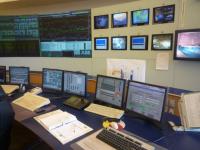-
Fukushima and the oceans: What do we know, five years on?
A major international review of the state of the oceans five years after the Fukushima disaster shows that radiation levels are decreasing rapidly except in the harbor area close to the nuclear plant itself where ongoing releases remain a concern. At the same time, the review’s lead author expresses concern at the lack of ongoing support to continue the radiation assessment, which he says is vital to understand how the risks are changing.
-
-
Managing the endangered Rio Grande River across the U.S.-Mexico border

The Rio Grande (called Rio Bravo in Mexico) is the lifeline to an expansive desert in the southwest United States and northern Mexico. From Colorado to the Gulf of Mexico, over 3,000 km, people depend on the river to quench their thirst and irrigate their crops. Yet as the river flows from the United States, it brings with it conflicts and challenges. The water level in the river is declining as use exceeds supply. Water demand is rising as the population in the region grows, and corresponding economic growth drives continued development. Moreover, climate change is expected to lower water levels even further, exacerbating the problems.
-
-
Building indestructible bridges
A design process called “form-finding,” inspired by the natural world, could make possible a new generation of indestructible bridges. Form-finding enables the design of rigid structures that follow a strong natural form — structures which are sustained by a force of pure compression or tension, with no bending stresses, which are the main points of weakness in other structures.
-
-
Increasing power grid cybersecurity

Cybersecurity experts are leading a new program to develop new data analysis methods better to protect the nation’s power grid. The goal of this project is to develop technologies and methodologies to protect the grid from advanced cyber and threats by developing the means to distinguish between power grid failures caused by cyber attacks and failures caused by other means, including natural disasters, “normal” equipment failures, and even physical attacks.
-
-
80% of EU oil imports now supplied by non-European companies
Non-European companies supply four-fifths of Europe’s oil imports, with Russian firms supplying more than one-third (36 percent) of imported crude, a new study on Europe’s foreign oil dependency has found. Just two of the top ten oil suppliers to the EU are European, and most of our imported oil is supplied from unstable countries.
-
-
Coconut shells inspire design ideas for earth-quake proof buildings

Coconuts are renowned for their hard shells, which are vital to ensure their seeds successfully germinate. Coconut palms can grow 30-meter high, meaning that when the ripe fruits fall to the ground their walls have to withstand the impact to stop them from splitting open. The specialized structure of coconut walls could help to design buildings that can withstand earthquakes and other natural disasters.
-
-
Lessons learned from the U.S.-Canada cross-border experiment
A tornado has just devastated a community on the border between the United States and Canada. Paramedics scramble to bring patients from over-crowded hospitals across the border. Communication blackouts and downed trees force ambulances to weave their way through blowing debris, fallen electrical lines, and car wrecks. The time for a routine trip from the injury site to the hospital has now tripled. While this did not really happen, it was the focus in April when the DHS S&T and several Canadian government agencies collaborated on a cross-border experiment with a focus on preparing emergency responders for this type of scenario.
-
-
Colorado county adopts NIST community resilience guidelines
The Boulder County Collaborative, a partnership of Boulder County, Colorado, communities formed in response to the catastrophic floods that struck the region in September 2013, has used the NIST Community Resilience Planning Guide for Buildings and Infrastructure Systems to develop and adopt its own resilience design performance standard for community facilities and infrastructure systems.
-
-
Modeling program helps efficient water management
For as long as civilization has existed, river basins have been the lifeblood of human settlement. And who is to say that ancient Babylon might not have benefited from a watershed management plan? Today there are many more people who rely upon water to a much greater degree, which is why a team of researchers has developed a modeling platform called Water and Energy Scenarios Testing — WEST — for integrated resource planning.
-
-
California droughts caused mostly by changes in wind, not moisture

Droughts in California are mainly controlled by wind, not by the amount of evaporated moisture in the air, new research has found. Their analysis showed that although moisture evaporated from the Pacific Ocean is the major source for California precipitation, the amount of water evaporated did not strongly influence precipitation in California, except in the cases of very heavy flooding. The research increases the understanding of how the water cycle is related to extreme events and could eventually help in predicting droughts and floods.
-
-
Understanding California electricity crisis may help prevent future crises
Between 2000 and 2001, California experienced the biggest electricity crisis in the United States since the Second World War. Exactly how it happened, however, is complex. New research now reveals insights into the market dynamics at play, potentially helping regulators standardize the market and prevent future crises.
-
-
Huge helium discovery in Tanzania is “a life-saving find”
Helium does not just make your voice squeaky — it is critical to many things we take for granted, including MRI scanners in medicine, welding, industrial leak detection, and nuclear energy. However, known reserves are quickly running out. Until now helium has never been found intentionally — being accidentally discovered in small quantities during oil and gas drilling. Researchers have developed a new exploration approach, and the first use of this method has resulted in the discovery of a world-class helium gas field in Tanzania.
-
-
Waterworld: Learning to live with flooding
Flash floods, burst riverbanks, overflowing drains, contaminants leaching into waterways: some of the disruptive, damaging, and hazardous consequences of having too much rain. But can cities be designed and adapted to live more flexibly with water – to treat it as friend rather than foe?
-
-
“Water windfall” beneath California’s Central Valley
New research indicates that California’s Central Valley harbors three times more groundwater than previously estimated, but challenges to using it include pumping costs — much of the water is 1,000 to 3,000 feet underground — ground subsidence, and possible contamination from fracking and other oil and gas activities.
-
-
Holocaust survivors give historic $400 million gift to Ben-Gurion University
A couple who survived the Holocaust and made a fortune investing with Warren Buffett left a $400 million bequest to Ben-Gurion University (BGU). The bequest, much of which is earmarked to fund water-related research, is expected to double the size of BGU’s current endowment. The university’s Zuckerberg Institute for Water Research focuses on sustainability of water resources, desalination techniques, and improving water quality.
-
More headlines
The long view
Helping Strengthen America’s Critical Infrastructure
Everyday life depends on a robust infrastructure network that provides access to running water, communications technology and electricity, among other basic necessities. The experts who keep our national infrastructure secure and resilient also need a strong network to share their knowledge and train the next generation of professionals capable of solving complex infrastructure challenges.
AI and the Future of the U.S. Electric Grid
Despite its age, the U.S. electric grid remains one of the great workhorses of modern life. Whether it can maintain that performance over the next few years may determine how well the U.S. competes in an AI-driven world.
Using Liquid Air for Grid-Scale Energy Storage
New research finds liquid air energy storage could be the lowest-cost option for ensuring a continuous power supply on a future grid dominated by carbon-free but intermittent sources of electricity.
Enhanced Geothermal Systems: A Promising Source of Round-the-Clock Energy
With its capacity to provide 24/7 power, many are warming up to the prospect of geothermal energy. Scientists are currently working to advance human-made reservoirs in Earth’s deep subsurface to stimulate the activity that exists within natural geothermal systems.
Experts Discuss Geothermal Potential
Geothermal energy harnesses the heat from within Earth—the term comes from the Greek words geo (earth) and therme (heat). It is an energy source that has the potential to power all our energy needs for billions of years.
